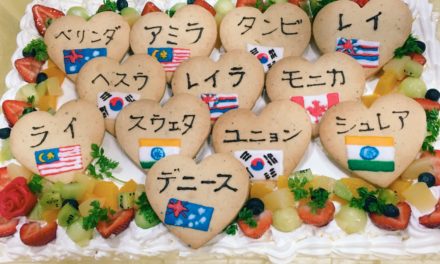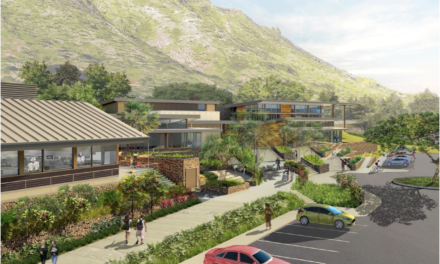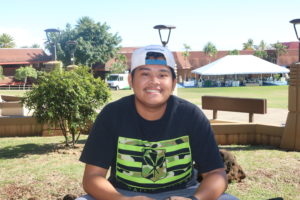By Cameron Enomoto | Staff Writer
After six years, the project to create the “Ka Wehena Kaiao” handbook for Kapiʻolani Community College will finally be available to students and faculty on Monday.
“Ka Wehena Kaiao,” which means “The breaking of dawn,” was created with the intent of helping readers discover the vast and beautiful history of KCC and Queen Kapiʻolani herself. While focusing on moving forward, it acknowledges the cultural significance of the land and the history and language of its people that surround the campus.
“If you’re going to make this your home, you need to take care of it and know what you’re taking care of,” said professor Kapulani Landgraf, one of the main contributors to “Ka Wehena Kaiao.”
On Monday, Chancellor Louise Pagotto will be sending an email containing the book as well as a flyer for activities related to its content.
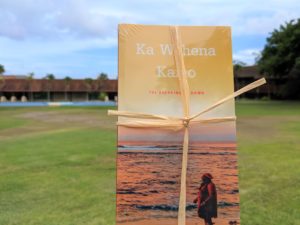
The handbook will be available to students and staff on Monday. (Photo by Kapi’o News staff)
The project was prompted by a three-year exchange program with the Waiariki Institute of Technology in Aotearoa (New Zealand). A grant to receive an international experience allowed one faculty member from each of the seven University of Hawaiʻi community college campuses to visit the school and learn more about their systems and practices.
Pagotto was the representative for the Kapiʻolani Community College. The institution in Aotearoa is bilingual and bicultural, meaning that both English and Maori are used. Maori protocol ceremonies are mandatory for all students, and the perpetuation of tradition is heavily incorporated into the cultural aspects of the school.
“I was just amazed,” Pagotto said. “The student body at Waiariki Institute of Technology was 60% Maori. At Kapiʻolani as a comparison, 20% of our students are Native Hawaiian.”
In Hawaiʻi, there are institutions that strive to uplift the Hawaiian community by offering courses related to the language or culture, but it is rare to find one that has immersive programs available for students. At the Waiariki Institute of Technology, a small booklet titled, “Tangatarua, Supporting biculturalism at Waiariki: A Guide for Staff and Students” was created to provide that valuable insight. The content in the book covers the extensive history of Aotearoa and the wisdom of the iwi, or local tribespeople.
“I saw this book and thought it would be cool if we could do something like this for our students because many used to spend a lot of time on campus,” said Pagotto. “They should know where it is, where it’s situated, and the history behind it.”
Though it was only an idea at the time, funding from the U.S. Department of Education gave the project necessary support. The Title III Part A Grant was developed to subsidize institutions that serve Native Hawaiian students. Money from the grant is awarded for five years, which allows the awardee to develop programs, finance renovations, and support student groups throughout campus. The funding that was awarded to Kapiʻolani Community College was for the purpose of promoting Native Hawaiian language and culture. From there, the production process for “Ka Wehena Kaiao” was underway.
“What you have now is the result of that small idea, funding from the U.S. Department of Education, and a lot of time, effort, and energy from all of the contributors in the book,” Pagotto said. “All of the writing, photographs, and design … was a labor of love, truly.”
The final copy of “Ka Wehena Kaiao” is meant to educate students and staff in a cultural and geographic context that will help them appreciate where they are at Kapiʻolani Community College and their role in ʻauamo i ke kuleana o ka lāhui Hawaiʻi, which means, “shouldering the shared responsibility of the Hawaiian people.”
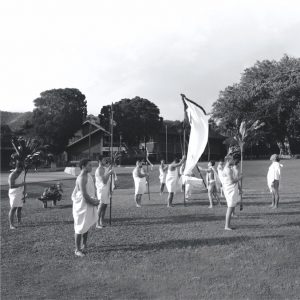
Hawaiian cultural practices being performed at Kapiʻolani Community College. (Screenshot from “Ka Wehena Kaiao”)
Similar to its inspiration, “Ka Wehena Kaiao” features its writing in two languages, Hawaiian and English. This highlights the significance of Hawaiʻi being the only state out of 50 to be officially recognized as bilingual. Having the book written in Hawaiian and English is a validation of the origin of the Hawaiian people and of ʻōlelo Hawaiʻi.
“I would love for students to celebrate the language,” Pagotto said. “There are lots of people on campus who are bilingual … they have a home language that is different from English. They are always thinking in two languages, and that kind of intelligence develops analytical skills which is what being a critical thinker and making sense of life is about.”
Even for those who are not bilingual, the English translation provides an abundance of insight that has the potential to instill a sense of appreciation of how the college came to be and what it means to them as a part of this lāhui, or community. Additionally, there are intersections and important parallels between Queen Kapiʻolani and what can be found on campus.
For instance, her focus on the well-being of the Hawaiian people as well as her interest in the deaf community is reflected today in the health and ASL programs that are offered to students. Ultimately, this ties into her shared motto with King Kalākaua, “Hoʻoulu, Lāhui,” to increase and preserve the nation and it is part of her legacy that students and staff should strive to embody.
Lastly, the wahi pana, or important places, play a role in how Kapiʻolani Community College came to be. They share connections to the geographic location of the campus and have a special value in Hawaiian culture. “Ka Wehena Kaiao” has a collection of moʻolelo, or stories, related to these areas and covers the history of the land before it was developed. The images that were carefully selected illustrate the beauty of these stories and shed light on the kauna (true meaning) behind them.
“If you’re going to make this your home, you need to take care of it and know what you’re taking care of,” said professor Kapulani Landgraf, one of the main contributors to “Ka Wehena Kaiao.”
The ʻAha Mole of ʻAha Kalāualani, which is the Native Hawaiian council at Kapiʻolani Community College, were also a huge part of the project. The council consists of Landgraf, Rosalie Fernandez, Lisa Linn Kanae, Drew Kahuʻāina Broderick, Keahou Mitchell-Aldan, Jennifer Bradley, Annie Keola Thomas, Kahelelani Cruz, and Nāwaʻa Napoleon.
There will be programs offered in the future for those who are interested to respectfully participate in cultural and traditional protocol via Zoom. More information about the meetings will be sent to students with a copy of the handbook.


